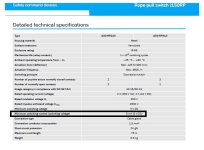i am having a pull cord switch far from the PLC by X meters, i want to check if the signal will reach the PLC input module
I am using 24 VDC
From allen bradley input module, i got the below information:
off-state current max = 1.5mA
on state current min = 2mA at 10VDC
on state current max = 10mA at 31.2 VDC
so my understanding is that since i am using 24 VDC, so that the maximum distance will be calculated as below:
for 1.5mm2 cross section cable, i cable resitance/distance = 12.8 ohm/km
cable resitance = x(km) * 12.8 ohm/km.
so the maximum impedance that i can reach is 5Kohm (10 VDC/2mA)...
however at this, cable distance will be very far so it is not logical, i guess noise should be taken into consideration in this case.
what is the best practice for getting the maximum distance that can be reached between a pull cord switch and a PLC input module.
thanks!
I am using 24 VDC
From allen bradley input module, i got the below information:
off-state current max = 1.5mA
on state current min = 2mA at 10VDC
on state current max = 10mA at 31.2 VDC
so my understanding is that since i am using 24 VDC, so that the maximum distance will be calculated as below:
for 1.5mm2 cross section cable, i cable resitance/distance = 12.8 ohm/km
cable resitance = x(km) * 12.8 ohm/km.
so the maximum impedance that i can reach is 5Kohm (10 VDC/2mA)...
however at this, cable distance will be very far so it is not logical, i guess noise should be taken into consideration in this case.
what is the best practice for getting the maximum distance that can be reached between a pull cord switch and a PLC input module.
thanks!





